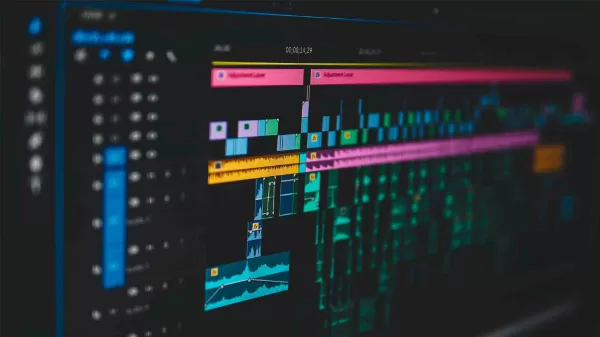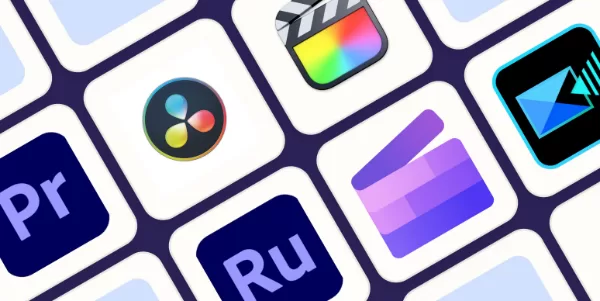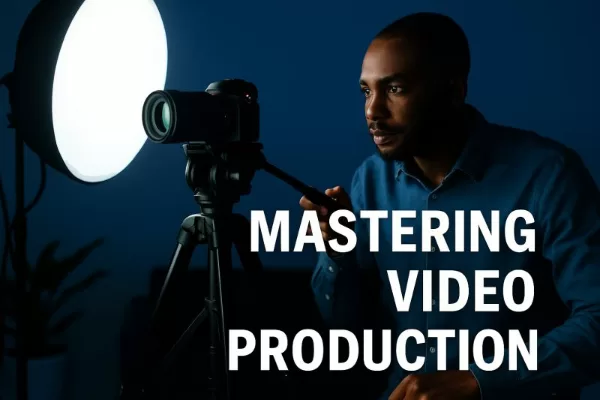Insights
Mastering the Video Production Process: Efficient Workflow for 2025
On Digitals
21/10/2025
11
The video production process is essential for creating impactful, high-quality content that resonates with audiences. In 2025, video continues to dominate as the most powerful medium for storytelling and brand engagement.
Before exploring how to optimize efficiency, let’s first understand the crucial role of video production in modern marketing.
The Role Of Video Production
Video production encompasses the entire content creation process from A to Z, playing a crucial role if your advertising campaign utilizes the video format. It starts with idea development, writing a script based on that idea, planning the footage, and covers technical steps like camera setup and recording.

Explore the video production process step by step
Given this core function, the video production process runs continuously and rigorously, divided into multiple stages to ensure the final high-quality video product accurately realizes your initial concept.
Explaining About The Video Production Process
The video production process is far more complex than simply hitting the record button. To transform an initial idea into a high-quality, engaging video that effectively delivers its message, the process of video production must go through multiple stages and be carefully managed from start to finish.
Understanding each stage of the video production process steps helps you allocate resources accurately, maintain timelines, and minimize potential risks. Essentially, the process of video production can be divided into the following five key stages.
5 Keys Stage Of A Video Production Process
Stage 1: Idea Development & Strategy
The first stage of the video production process focuses on transforming an initial concept into a clear creative strategy. Based on the idea’s feasibility, this phase defines your main objectives (KPIs), the message you want to communicate, and an outline of the necessary footage.
This foundational step within the process of video production ensures that you and your partners align on the project’s content, overall direction, and measurable success metrics, paving the way for smooth progress in later stages.
Stage 2: Pre-Production
During the pre-production stage, preparations are intensified. Key tasks include determining the detailed budget, finalizing the project scope, developing the script and storyboard, scouting filming locations, and selecting actors or models.

Pre-production – the backbone of the video production process
This is one of the most crucial video production process steps, as it ensures every element is fully prepared. With everything in place, the actual production phase can begin without unnecessary delays or interruptions.
Stage 3: Video Production
Once all pre-production tasks are complete, the production phase officially begins. This is where the creative vision takes shape, setting up lighting, equipment, and camera angles to capture footage according to the plan.
This stage of the process of video production may also involve on-set voice recording or studio sessions to collect all necessary raw materials for the post-production phase.
Stage 4: Post-Production
After filming, the project enters the post-production stage, one of the most detailed video production process steps. The collected footage is edited, color-graded, and enhanced with music, sound effects, and voice-overs.

Perfecting every frame in the video production process
Typical tasks during this stage include:
- Adding background music
- Recording voice-overs or narration
- Inserting subtitles and visual effects
At this point, your video evolves from raw footage into a polished, professional product, ready for final review and distribution.
Stage 5: Distribution
The final step in the process of video production is distribution – sharing your completed video with the right audience. Depending on your marketing objectives, the video can be distributed on platforms such as TV, your company’s website, or social media channels like YouTube, Facebook, and TikTok.
Selecting the most suitable platforms and optimizing your video format are critical video production process steps for achieving maximum visibility, engagement, and overall campaign success.
A well-structured process of video production does more than just organize tasks, it ensures every creative and technical element works together to deliver a clear, impactful message. Let’s dive into why the video production process is important and how mastering it can determine the overall success and quality of your final product.
Why Is Video Production Process Important?
If you decide to start a video project the moment an idea pops into your head without a structured plan, things can quickly become chaotic and difficult to recover, wasting valuable manpower, time, and budget.
Therefore, having a clearly defined video production process from the beginning is essential to ensure a high-quality, professional product delivered on time.

A smooth video production process ensures quality
A well-organized process of video production brings several important benefits to any project, including:
- Ensuring Quality Consistency: Establishing a clear and systematic video production process helps maintain consistent quality across all videos while allowing room for creativity and brand personalization. By following each step of the process of video production, teams can produce content that aligns with both technical standards and creative goals.
- Aiding Risk Management and Cost Savings: A detailed pre-production plan within the video production process helps identify potential risks early and eliminate them before they escalate into unexpected costs during production. This proactive approach not only saves budget but also ensures smoother project execution throughout the process of video production.
- Optimizing Resources and Time: With a well-structured production process for every stage, you’ll know exactly who is responsible for what, when each task needs to be completed, and how to keep the project on schedule. This clarity prevents delays, avoids work overload, and maximizes team efficiency across the entire process of video production.
- Effective Collaboration: Thorough preparation in the video production process helps the entire crew understand the project goals, creative direction, and expected outcomes. When everyone shares the same vision, collaboration becomes more effective, ensuring the final product truly reflects the intended message and brand identity.
Understanding why the production process matters is just the first step. By improving each stage of the process of video production, you can save time and enhance quality.
Let’s explore the best practices for an efficient video production process.
Best Practices For Efficient Video Production Process
To ensure your video project runs smoothly and stays within budget, it’s essential to follow a well-structured video production process. By applying the right methods in every phase of the process of video production, you can prevent costly mistakes and achieve a polished final product.
- Pre-production is a must: Never begin shooting without a clear creative brief or shot list. These elements are the foundation of an efficient video production process. Proper preparation during this stage saves a significant amount of time, reduces unnecessary costs, and ensures that everyone shares the same creative vision.
- Prioritize Technical Quality: You must invest in equipment like cameras, microphones, and lighting gear to capture beautiful footage and authentic sound. Additionally, even if you don’t use sync sound, you should still record raw sound as basic material to give the post-production team more resources to work with.
- Resource Management: Double backup all data immediately after shooting, and establish a systematic file and folder naming convention for easy retrieval.
- Optimize the Feedback Process: You and your partner should set specific feedback milestones for each phase. This helps prevent a situation where you have countless “final” versions but no officially approved product.
Necessary Tools for Video Editing
A well-equipped post-production phase is crucial for completing a professional and efficient video production process. Below are the essential tools and resources that will help streamline your workflow:

Tools that elevate your post-production workflow
Professional Video Editing Software
- Adobe Premiere Pro: The industry standard for editing, ideal for projects of all sizes, and fully compatible with After Effects for advanced motion graphics.
- DaVinci Resolve: A powerful free alternative offering excellent color grading, editing, and audio post-production capabilities.
Essential Hardware and Resources
- High-Speed Storage: An external SSD is essential for handling large video files smoothly without lag. It ensures faster rendering and playback during the process of video production.
- Licensed Resources: Use platforms like Epidemic Sound or Artlist for background music to comply with copyright laws and prevent removal on platforms such as YouTube or Facebook.
- After Effects / Photoshop: These tools are indispensable for creating engaging motion graphics, visual effects, and eye-catching thumbnails, all vital for enhancing the final stage of the process of video production.
FAQ: Mastering the Video Production Process: Efficient Workflow for 2025
What is the video production process?
The video production process is a structured workflow that covers every stage of video creation, from developing an idea and writing the script to filming, editing, and distribution. Each phase of the process of video production plays a vital role in ensuring the final video meets creative, technical, and strategic goals.
What are the main stages of the video production process?
The video production process typically includes five key stages:
- Idea Development & Strategy
- Pre-Production
- Production
- Post-Production
- Distribution
Each step in the process of video production builds on the previous one to ensure efficiency, consistency, and a high-quality end product.
Why is having a structured video production process important?
A clearly defined video production process helps maintain quality consistency, optimize resources, and prevent unnecessary costs. When each stage of the process of video production is well-planned, it ensures smoother collaboration, better communication, and timely delivery of the final video.
What are the best practices for an efficient video production process?
To improve workflow and save time, always start with solid pre-production planning, prioritize technical quality, and set clear feedback milestones. Managing resources efficiently and using professional editing tools are essential for optimizing the entire process of video production.
What tools are recommended for the post-production process?
For a professional video production process, use tools like Adobe Premiere Pro or DaVinci Resolve for editing, After Effects for motion graphics, and Photoshop for thumbnails. Pair these with licensed music libraries (Epidemic Sound, Artlist) and high-speed SSD storage to make the post-production process of video production faster and more reliable.
Mastering Your Video Production Process With On Digitals
On Digitals is a creative digital agency specializing in strategy, content, and video production. With a data-driven and audience-first approach, we craft stories that connect brands with people. Our expertise ensures every video project delivers impact, creativity, and measurable results.

Perfecting every stage of the video production process
The video production process is more than just filming, it’s a strategic journey from idea to delivery. By mastering each stage of the process of video production, teams can improve efficiency and quality. A well-planned workflow helps brands create consistent, engaging videos that stand out in 2025 and beyond.
NEWEST POSTS
- How To Spot Fake Followers On Influencer Profiles And Boost ROI
- Nano Vs micro influencers: Key differences And Best Uses
- Google Core Web Vitals Optimization & Page Speed
- Micro Influencer Marketing For Better Reach And Stronger Engagement
- How to Build Topical Authority SEO for Stronger Rankings and Trust Online
Read more
